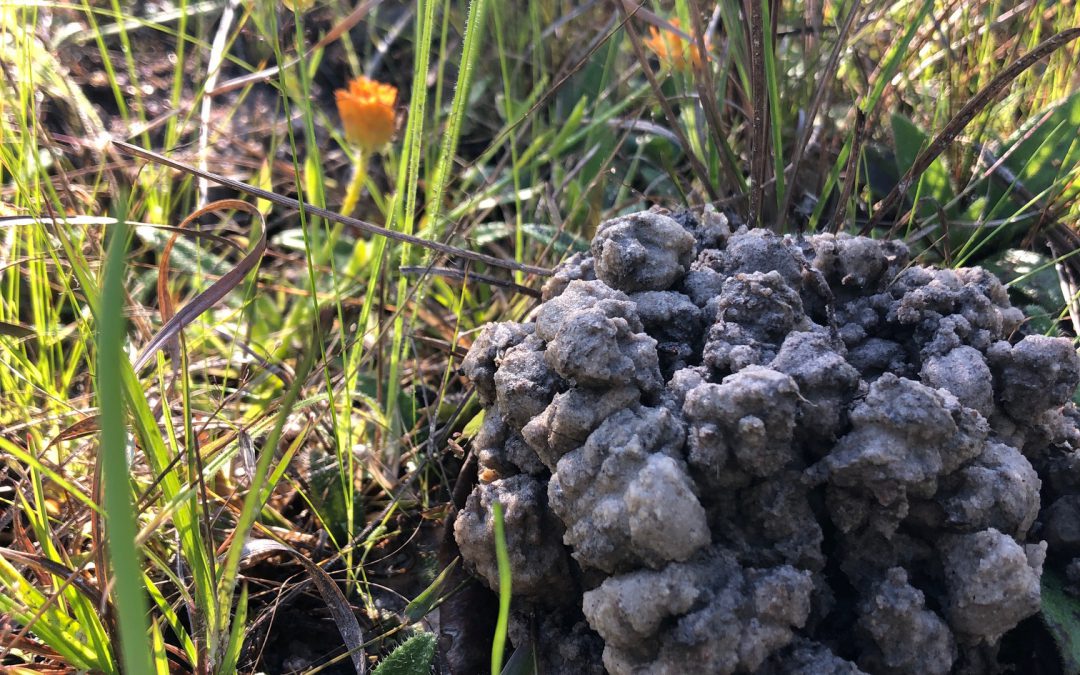
by Carrie Stevenson | May 15, 2020

Crawfish boils are popular in the springtime. Crawfish are generally harvested from aquaculture operations. Photo credit: Libbie Johnson, UF IFAS Extension
“You get a line, I’ll get a pole, we’ll go down to the crawdad hole, honey, baby, mine“…there are lots of great zydeco songs singing the praises of crawfish (aka crayfish, crawdads, mudbugs). They are in season now, and while crawfish festivals all around the southeast are canceled due to concerns over COVID-19, they are still available and make for great eating. Most of us would recognize a cooked one alongside a feast of corn and potatoes, but would you know an actual crawfish hole if you came up on it?
Last fall, our office welcomed about 500 kids (over several days) to the 4-H camp in Barrineau Park for a field trip. I showed every single one of them a small muddy mound with an opening in the top, and asked if anyone could tell me what it was. Not a single kid knew! Now, I make sure I point crawfish mounds out to anyone I happen to be walking with, as they are fascinating little structures. Also referred to as crawfish chimneys due to their upright, open construction, they are built by a crawfish in a muddy area, often near a creek or other water source.

Crawfish mounds are constructed using small pellets of mud, and the opening connects down to a burrow. Photo credit: Carrie Stevenson, UF IFAS Extension
The industrious invertebrate uses its legs and mouth to create pellets of mud as it digs its burrow. It places mud up above the ground, using the mud balls like small bricks. Bricking up the entrance to its burrow (as opposed to placing discarded mud elsewhere) also protects a crawfish from exposure to predators on open soil. The crawfish chimneys can be 6 inches tall (or more!) and connect down to a burrow that may reach 3 feet deep, some straight down and others with side tunnels extending different directions.
Since the crawfish lives in wetland areas, it is theorized that these chimneys extending above the soil allow for better oxygen flow in the burrow. During a drought, crawfish will plug the opening of their mounds with mud, to keep water in the burrow from evaporating.
Crawfish in the wild are rarely harvested, although some folks do fish for them like the song referenced earlier. For the vast majority of crawfish harvested in commercial production, two species are the most popular–the white river crawfish (Procambarus zonangulus) and red swamp crawfish (Procambarus clarkii). They are typically farmed in coordination with rice, as both commodities thrive in flooded conditions. Most aquaculture operations are associated with Louisiana, but at least five other southern U.S. states farm crawfish. To learn more about this industry, check out LSU AgCenter’s informative video.
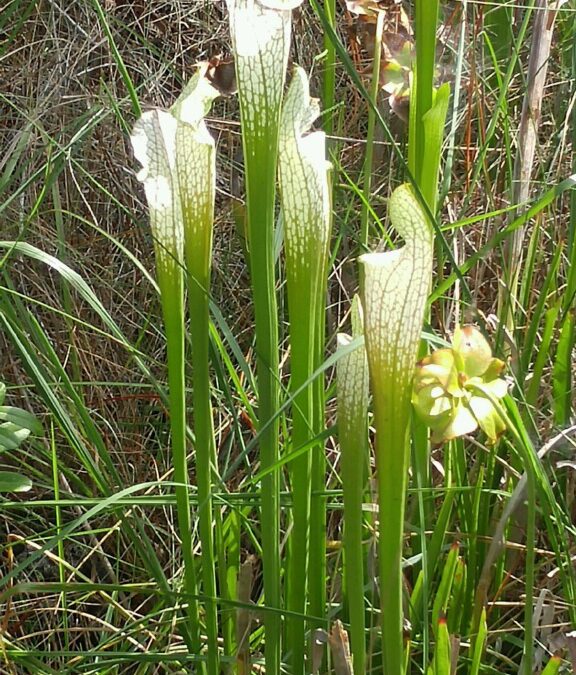
by Carrie Stevenson | Apr 30, 2020
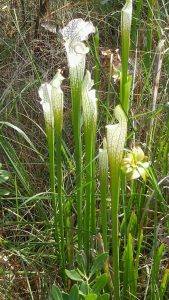
White-topped pitcher plants in bloom at Tarkiln State Preserve. Photo credit: Carrie Stevenson, UF IFAS Extension
If you live in northwest Florida or southeast Alabama and have never laid eyes on our wild native carnivorous plants, it is about time! April and early May are the best time to see them in bloom. We have six species of pitcher plants (Sarracenia), the most common being the white-topped (Sarracenia leucophylla). However, they come in multiple colors, from yellow and red to a deep purple, and in different sizes.
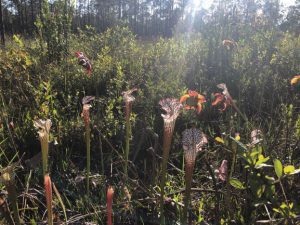
Pitcher plants and their pinwheel-shaped flowers at Splinter Hill Bog. Photo credit: Carrie Stevenson, UF IFAS Extension
One thing they have in common, though—they eat meat. Carnivorous plants all over the world have evolved in places that left them few other options for survival. These plants are typically found in extremely wet, acidic, mucky soils with very low nutrient levels. Normally, plants uptake nutrients like nitrogen and phosphorus from the soil around them. Not being available in these particular environments, carnivorous plants (or more specifically, insectivorous) developed a way to extract nutrients from insects.

Small parrot pitcher plants lie on the ground instead of standing upright at Blackwater State Forest. Photo credit: Carrie Stevenson, UF IFAS Extension
So how does it work? Pitcher plants have a modified leaf, which instead of lying out flat like most plants, is rolled up into a tube, or “pitcher” shape. The inside of the pitcher has a sweet sap, and the walls of the tube are lined with tiny, downward-pointing hairs. Separate from the leaf, the plant has an elaborate flower structure, which attracts insects for pollination. While nearby, these insects are also attracted to the colorful leaf and the sweet sap in its pitcher. The insect will land on the lip of the leaf, then crawl down.
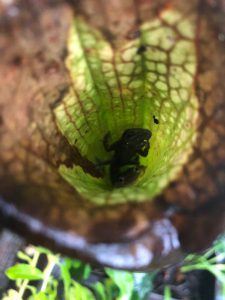 Those sticky, downward facing hairs are a trap, preventing insects from leaving the pitcher. Enzymes—a cocktail of proteins naturally found in many other plants but used creatively here—in the sap break down the bug bodies and convert them to nutrients for the plant. In fact, if you slice a cross-section into a pitcher wall or break open a dried one, you will see countless dried exoskeletons at the bottom of the tube. Several other enterprising species have taken advantage of the pitcher plant’s creative structure. More than once, I have seen tiny spiders spin webs across the mouth of the tube, or small lizards and frogs at the bottom, waiting patiently for prey.
Those sticky, downward facing hairs are a trap, preventing insects from leaving the pitcher. Enzymes—a cocktail of proteins naturally found in many other plants but used creatively here—in the sap break down the bug bodies and convert them to nutrients for the plant. In fact, if you slice a cross-section into a pitcher wall or break open a dried one, you will see countless dried exoskeletons at the bottom of the tube. Several other enterprising species have taken advantage of the pitcher plant’s creative structure. More than once, I have seen tiny spiders spin webs across the mouth of the tube, or small lizards and frogs at the bottom, waiting patiently for prey.
Some of the best places to see pitcher plants in the area—they also bloom in October—are Tarkiln Bayou State Preserve, Weeks Bay National Estuarine Research Reserve, Splinter Hill Bog Preserve, and Blackwater State Forest.
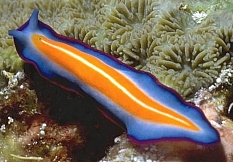
by Rick O'Connor | Apr 30, 2020
Okay, this is a gamble.
I began this series to celebrate the year of the Gulf of Mexico – “Embracing the Gulf 2020”. The idea was to write about the habitats, creatures, economic impacts, and issues surrounding the “pond” that we live on. I did a few introductory articles and then jumped right into the animals. We began with the fun ones – fish, sea turtles, whales – and now we are in the more unfamiliar – invertebrates like sponges and jellyfish.
But worms? Really? Who wants to read about worms?
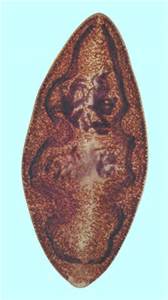
A classic flatworm is this lung fluke.
Photo: Kansas State University.
Well, there are a lot of them, and they are everywhere. You will find in many sediment samples that worms dominate. They also play an important role in the marine community. They are great scavengers, cleaning the environment, and an important source of food in the food chains of the more familiar animals. But they are gross and creepy. When we find worms, we think the environment is gross and creepy – and sometimes it is, remember they CLEAN THE ENVIRONMENT. But worse is that many are parasites. Yes… many of them are, and that is certainly gross and creepy. Flukes, tapeworms, hookworms, leeches, who wants to learn amore about those? Well, honestly, parasitism is an interesting way to find food and the story on how they do this is pretty interesting… and gross… and creepy. Let’s get started.
According to Robert Barnes’ 1980 book Invertebrate Zoology, there are at least 11 phyla of worms – it is a big group. We are not going to go over all of them, rather I will focus on what I call the “big three”: flatworms, roundworms, and segmented worms. We will begin with the most primitive, the flatworms.
As the name implies, these worms are flat. They are so because they are the last of what we call the “acoelomate” animals. Acoelomates are animals that lack an internal body cavity and, thus, have no true body organs – there is no where for them to go. So, they absorb what they need, and excrete, through special cells in their skin. To be efficient at this, they are flat – this increases the surface area in contact with the environment. There are three classes of flatworms – one free swimming, and two that are parasitic.

This colorful worm is a marine turbellarian.
Photo: University of Alberta
The free-swimming ones are called turbellarians. Most are very small, look like leaves, very colorful, and undulate as they swim near the bottom. They have “eye-like” cells called photophores that allow them to see light – they can then choose whether to move towards the dark or not. They have nerve cells but no true brain, and one only one opening to the digestive tract – that being the mouth, so they must eat and go to the bathroom through the same opening. Weirder yet, the mouth is usually in the middle of the body, not at the head end. Some are carnivorous feeding on small invertebrates, others prefer algae, others are scavengers (CLEANING THE OCEAN). They can reproduce by regenerating their bodies but most use sexually reproduction. They are hermaphrodites – being both male and female. They can fertilize themselves but more often seek out another worm. Fertilization is internal and they lay very few eggs.
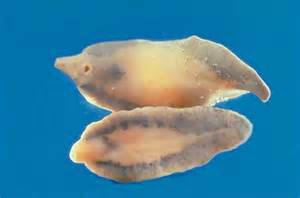
The human liver fluke. One of the trematode flatworms that are parasitic.
Photo: University of Pennsylvania
The second group are called trematodes and they are the parasites we know as “flukes”. We have heard of liver flukes in livestock and humans, but there are marine versions as well. They have adhesive organs located at the near the mouth that help hold on, and a type of skin that protects them from their hosts’ defensive enzymes. They feed on cells, mucous, and sometimes blood – yep… gross and creepy. Some are attached outside of their hosts body (ectoparasites) others are attached to internal organs (endoparasites). The ectoparasites breath using oxygen (aerobic), endoparasites are anaerobic. Like their turbellarian cousins, they are hermaphroditic and use internal fertilization to produce eggs. They differ though in that they produce 10,000 – 100,000 eggs! Their primary host (the one they spend their adult life feeding on) is always a vertebrate, fish being the most common. However, their life cycle requires the hatching larva find an intermediate host where they go through their developmental growth before returning to a primary host. These intermediate host are usually invertebrates, like snails. The eggs are released with the fish feces – a swimming larva is released – enters a snail – begins part of the developmental growth – consumed by an arthropod (like a crab) – completes development – and the crab is consumed by the fish – wah-la. The adults are usually found in the gills/lungs, liver, or blood of the vertebrate hosts. Gross and creepy.

The famous tapeworm.
Photo: University of Omaha.
Better yet are the tapeworms. We have all heard of these. They are also all parasites, but all are endoparasites. Weirder, they do not have a digestive tract. Gross and creepy. Their heads are very tiny compared to their bodies and have either four sets of suckers, or hooks, to hold onto the digestive tract of their hosts (usually vertebrates). The head is actually round but the body is very flat and divided into squares called proglottids. Each proglottid gets larger as you move towards the tail and each possesses all of the reproductive material needed to produce new worms – they too are hermaphrodites. They also have a type of skin that protects them from the enzymes of their hosts. They also require an intermediate host to complete their life cycle so the proglottids will exit the hosts body via feces and complete the cycle similar to the trematodes.

I began this with a comment on how worms benefit the overall marine environment of the Gulf. It is hard to see that in these flatworms. They are either just another consumer out there, or nasty parasites others in the community must deal with. Well… we look at the roundworms next time and see what they have to offer.
Reference
Barnes, R. 1980. Invertebrate Zoology. Saunders College Press. Philadelphia, PA. pp. 1089.
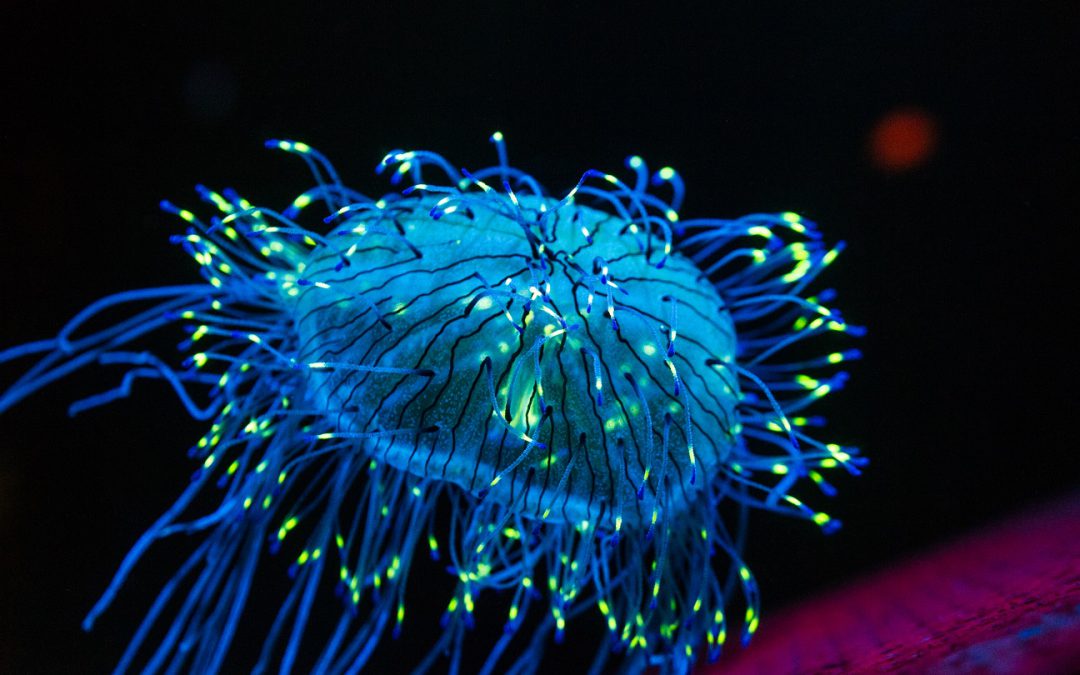
by Erik Lovestrand | Aug 16, 2019
If you like summer fireworks events, there is a great show ongoing during our warm summer months that you shouldn’t miss. Find an unlit dock along our coastal environs and take the time to pause, get down on your knees, and gaze into the starry… water. Our night skies are quite impressive in their own right, but our night waters will also put on an amazing show of glowing critters and flashing lights if you take the time to notice. Thousands of different marine organisms have the ability to produce light and the purposes served by this trait are many. Some animals use this tactic as camouflage and others to stand out for one reason or another. Being seen by others can assist with predation (luring), defense (startling or warning), or even reproduction (attracting a mate).
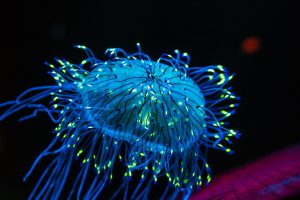
Thousands of marine creatures create their own light, including many jelllyfish
Bioluminescence is the most accurate term for light emitted by living organisms; although sometimes you will hear it referred to as fluorescence or phosphorescence. Fluorescence however, is the term describing something that absorbs light energy from an external source and then almost immediately re-emits it. When the external source goes away, so does the fluorescence; i.e. it doesn’t keep going in the dark. Phosphorescence describes when something absorbs light energy from an external source and then slowly re-emits it over a longer timeframe, i.e. glowing stickers. In contrast to these other terms, bioluminescence results from a chemical reaction within the body of an organism. The trigger mechanisms can be quite varied in nature and some are even directly controlled by linkages with an animal’s brain and nervous system. Other times the light is triggered simply by a physical disturbance. This is the most common phenomenon observed by people as the water seems to sparkle from a boat’s wake at night or waves breaking in the surf. One of my earliest memories of this was as a teenager in the Keys while wading along the shore at night. Each splash would trigger a shower of sparks.
So, what is taking place to create this chemical reaction that gives off light? Well, scientists have learned a lot about it but still don’t have all of the answers regarding the incredible variety of ingredients and processes involved in the bioluminescent realm. In general, a molecule called luciferin is involved and when exposed to oxygen, it gives off light. An enzyme named luciferase acts as a catalyst to help speed up the reaction. There are apparently many types of luciferins utilized by different animals; and I’m guessing, many variations on the actual luciferases involved too.
During summertime the warm waters of the Gulf and our coastal estuaries are rich with planktonic life. If you look close at a dock post beneath the water you will see continual, tiny flashes being triggered as water moves around the stationary post. When you walk down the dock (very carefully, without a flashlight), you can also see streaks of light from startled fish swimming away. This light is emitted by single-celled dinoflagellates that are triggered by a disturbance near them. One fascinating account I’ve read, told the story of Jim Lovell (Apollo 13 astronaut), who used bioluminescence to find his way safely home. When the navigation equipment failed at night in the navy plane he was flying, he was able to turn off his cockpit lights and see the glowing wake from his carrier and follow it. I’m sure he was forever grateful to the tiny marine creatures that made this possible! If you can get to a coastal dock near you this summer, be sure to turn out the lights, and look down in the water for a spectacular, miniature fireworks show. No earplugs required.
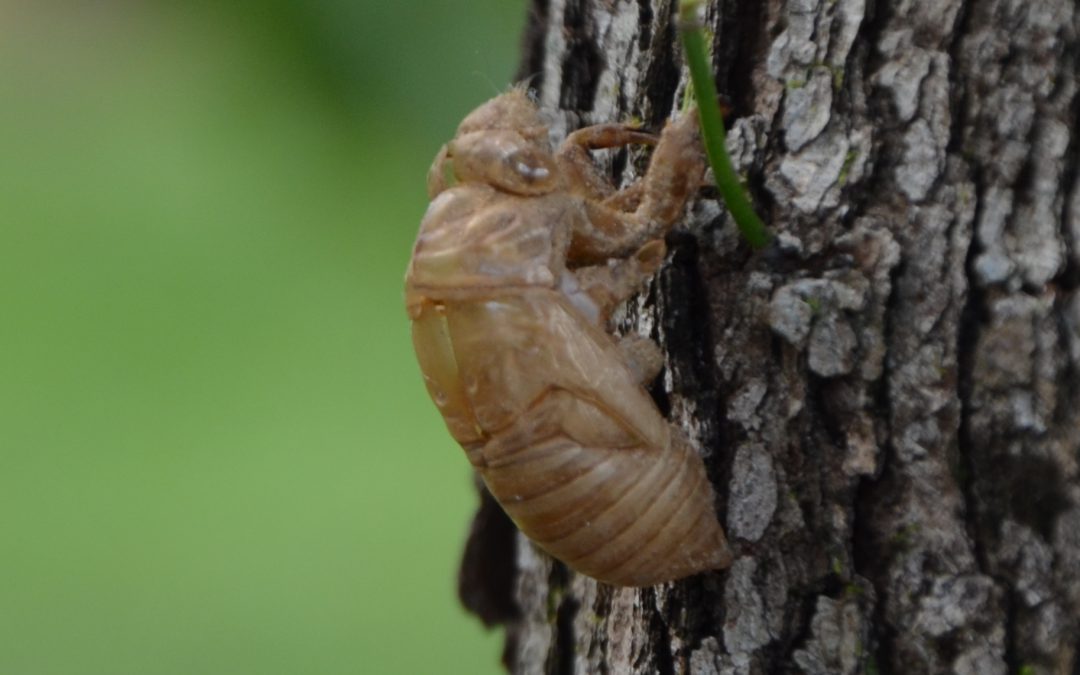
by Les Harrison | Oct 26, 2018

Only a shell of its former self, the exoskeleton shed by a cicada is all that remains of the previous night’s long pursuits.
Autumn evenings in the panhandle are usually beginning to reflect the official change of seasons with cooler air and a slight lessening of the raucous din created by insects and birds. The recent early-fall hurricanes have brought the area a wide breath of hot, humid air, delaying the long anticipated start of relief from the sultry summer environment.
Anyone hearty enough to take an early evening walk in north Florida will experience a continuation of the frenetic activity and riotous sounds typical to summer in the south. The near deafening call of cicadas (Magicicada spp.) is part of the cacophony.
Once commonly identified as locust in the region, their near-mechanical buzzing originates from the protection of foliage in trees and bushes during the day or twilight hours. During the dark hours they sing often and relocate frequently.
It is important to note cicadas are not the locust of infamy which shred the green, lush landscapes and foretells famine. While locust and cicadas are both insects, the similarities end there.
These seldom seen or captured insects known for their boisterous, sometimes undulating, chorus do leave strategically placed souvenirs for the sharp-eyed observer. This discarded residue of their early life stages is a highly valued tool for many elementary school boys with a prank in mind. The hard shell is harmless, but under the right conditions does have a certain shock value appreciated by juvenile miscreants.
Their nymph stage skeletons are often seen on the trunks of trees, shrubs stalks and even the siding of buildings. The opaque brown shells are abandoned when the cicada outgrows it and then emerges to form a new exterior.
The process is similar in other insect species with an exoskeleton having very limited potential for growth and expansion. The rigid coating provides this creature an armored surface to fend off the challenges of being small and small in a big hungry world.
In some states, cicadas are famous for their periodic appearance in colossal numbers, sometimes as many as 1.5 million per acre. These once every 13 to 17 year swarms do not occur in Florida which has an insect friendly environment.
The 19 Florida cicada species fall into three groups based on overall size measured by the length of the forewings. They produce their songs with timbals, paired drum-like structures on the sides of the abdominal segments.
A muscle attached to the timbal plate causes the timbal ribs to pop inward and project outward when relaxed. Flexed rapidly, the cicada chorus can deliver hours of uninterrupted night music.
In Florida, only males have timbals and the females are mute. Most sounds made by males are calling songs which serve to attract the silent females.
Cicada nymphs live in underground burrows where they feed on xylem sap from roots of grasses or woody plants. Because xylem sap is low in nutrients, complete nymph development takes several years to successfully mature.
All cicada species molt four times underground. When the cicada nymph is ready for its fifth and final molt it makes its way to the soil’s surface. It climbs a short distance up a tree trunk or stem, anchors itself and molts for the last time becoming an adult.
If male, the new cicada will add its contribution to the nightly festivities. If female, she will quietly wait for that special, one in a million, nocturnal crooner.
To learn more about north Florida’s noisy night insects, contact the local UF/IFAS County Extension Office. Click here for contact information.
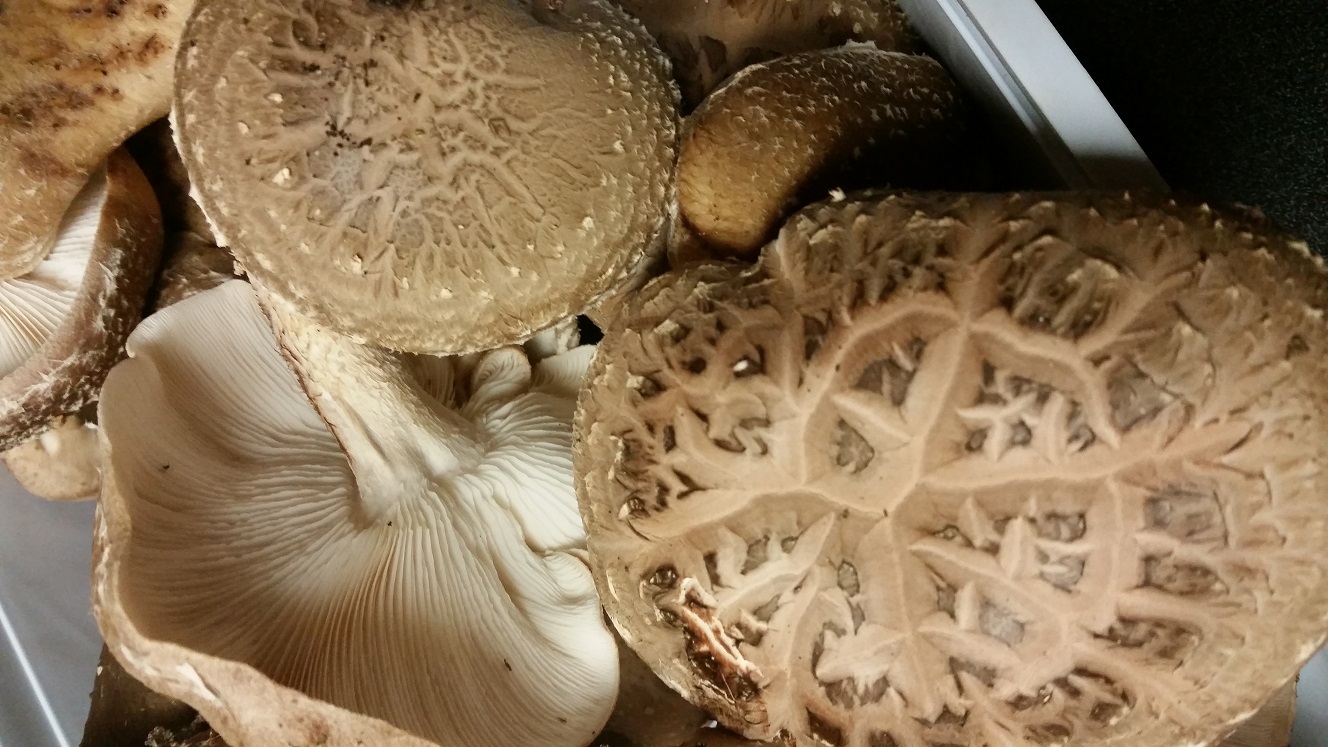
by Erik Lovestrand | Jun 8, 2018
Have you ever eaten a wild mushroom and then wondered afterwards if you might have made a mistake? If you are prone to forage outdoors for tasty treats from nature, I’ll bet you have. The problem is, unless you are harvesting one of a few “foolproof” species of edible fungi, positive identification can be very challenging. Oft-times wild mushroom harvesters take a notion to branch out and seek new varieties that are outside of the identification capabilities of the novice mycologist. This is where folks begin treading on dangerous ground and may be at risk for gastrointestinal distress;
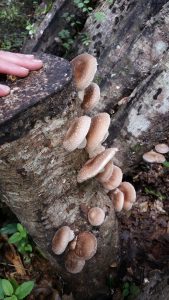
Properly inoculated shiitake logs can be quite productive
with symptoms that may range from a mild upset stomach to permanent damage or death.
Yes, death!
Everyone has heard about poisonous mushrooms but few people realize that some of the deadliest species are look-alikes for some of the tastiest species. And you would not be able to distinguish the difference by nibbling a sample. Even a small sample of some of the “bad actors” can be lethal, leading to painful symptoms and organ failure. If this scares you out taking a risk then this article has served a good purpose.
If you wish to enjoy a safe, tasty experience with a highly-prized mushroom species, just take up the hobby of growing your very own shiitake mushrooms. Shiitake comes from the root Japanese “shii” (meaning oak) and “take” (for mushroom). Shiitake mushrooms are a billion dollar industry in Asia with 92% of the world production coming from Japan. Many culinary and medical uses have been identified. This species was only available as dried mushrooms in the US until 1972 but with the removal of a ban on importing live fungi a commercial industry has blossomed.
Hardwood logs are the key, with oak being a preferred tree species. There are six considerations if you are to be successful:
1. You must acquire living Shiitake inoculum (the mycelial or rooting stage) already growing on a wood medium, usually hardwood dowels or sawdust (internet search will yield many providers).
2. Proper cutting and handling of the logs to be inoculated is important. Cut trees close to the time of inoculation (2 weeks max.), 4-8 inch diameter and 3-4 feet long.
3. Inoculate by drilling holes in the logs, inserting the living inoculum/spawn and seal the holes with melted wax to retain moisture. A single log may have 30-40 holes drilled in it.
4. Place logs in a shady/moist environment (i.e. under the canopy in a woodlot with at least 75% shade).
5. Maintain logs by wetting during dry spells. A sprinkler or mister run for a couple of hours a day works well.
6. Proper harvesting and storage is most important and information is available in many places online.
Shiitake fruiting is usually triggered by changes in temperature and humidity so spring and fall are key times to check your logs. It does not take long for a mushroom to go from the early “pinning” stage to mature, so weekly checks are advised. Significant tropical weather events will also stimulate fruiting. Logs produce mushrooms for at least two years, until the nutrients in the wood are used up.
Don’t be in a hurry though, as the full colonization of the log by the mushroom mycelium will take up to 9 months before mushrooms begin to appear. Remember, beware the risks of harvesting wild fungi. A small-scale shiitake growing operation is a safe alternative for getting your “mushroom-fix.” Also, be ready to compete with a squirrel or two for your crop as they know a good thing when they see it too.



















